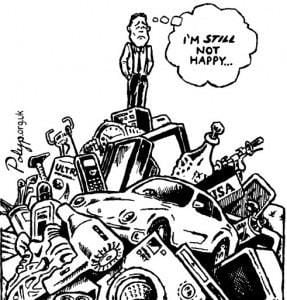One sunny Labor Day, I had the opportunity to go boating with a group of six high schoolers in the clear blue waters off the coast of Miami. Six of us enjoyed the beautiful weather while swimming and water-skiing off the back end of a pretty impressive boat that belonged to Dave’s father. When it was Dave’s turn to ski, I went to the back of the boat to slide him the skis while he dove into the water. When he came up out of the water, he leaned back and let out a comfortable sigh. “Ahhhh,” he said. “I wonder what the poor people are doing today.”
Dave had verbalized an attitude that’s been way too common in our culture for way too long. In fact, Jesus addressed its presence 2000 years ago. We have become so consumed with meeting our own needs that we forget about or don’t even care for those less fortunate than ourselves. Our actions, particularly our lack of assistance to others, especially the poor, reveals the fact that we are satisfied with being self-centered.

Tom Sine feels that adults are selling young people the wrong dream: “We all seem to be trying to live the American Dream with a little Jesus overlay. We talk about the lordship of Jesus, but our career comes first. Our house in the ‘burbs comes first. Then, with whatever we have left, we try to follow Jesus.”[2]
We may speak out against materialism, entitlement, and greed, but we are functionally following a narrative that is clearly anti-Gospel.
More and more of today’s teens, even many (most likely most) who profess faith in Christ, see nothing wrong with this type of lifestyle, in spite of the fact that Jesus called his followers to be totally committed to him, as opposed to being preoccupied with their own material needs. As one who speaks from experience, I can tell you that the more I have, the more those things that I have cloud or block my view of Christ and his calling.
Perhaps we shouldn’t be surprised by the selfish reflection we see of ourselves in the mirror of today’s youth culture wherever and whenever we encounter it. Our kids have been exposed to the disease of self-centeredness. And like those of us who are adults, our kids run the risk of living with the disease so long that they forget that they even have it.
But we can’t stop at being surprised. Jesus has called us to “follow” him by prioritizing obedience to his will and his way at the top of our earthly pursuits. The best way to lead our children and teens into a life of faithful obedience is to pursue faithful obedience ourselves. Leading the guiding your own kids begins with looking into the mirror and staring at your own heart. As Jesus said, “For where your treasure is, there your heart will be also” (Matthew 6:21).
So, where is your heart? Then, along with modeling faithful obedience that puts earthly things in their proper place, we must preach the same Gospel to the hearts of our kids. Finally, adjust your spending and living habits to more clearly reflect Kingdom priorities, investing your overflow of time and money in ways that help others. Instead of arrogantly wondering what the poor people are doing today, humbly minister to those in need. . . with deep gratitude to God for what you’ve been given.
And youth workers. . . do an audit of your own ministry budget and spending. It will clearly show you the trajectory of your ministry.
[1] Kenneth S. Kantzer, “Ron Sider Is Mostly Right,” Christianity Today, 8 October 1990, 21.
[2] Tom Sine, “Will the Real Cultural Christians Please Stand Up,” World Vision, October/November 1989, 21.